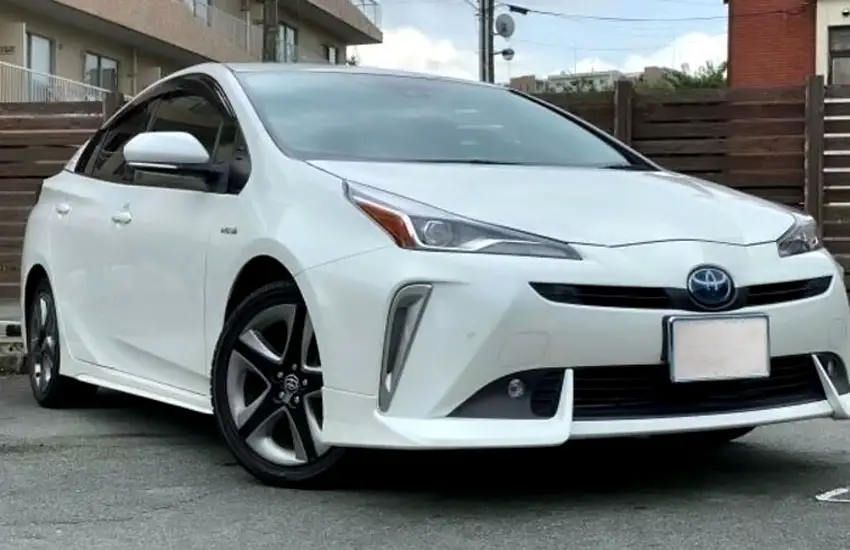As an Amazon Associate, I earn from qualifying purchases at no extra cost to you.
How to Tell If Your Power Steering Pump is Bad: A Complete Guide
Power steering is one of those modern car features that we all take for granted until something goes wrong. A faulty power steering pump can cause a ton of frustration, but how do you know if that's what's happening? Let's dive into the signs and symptoms so you can figure out if your pump needs attention – and quickly!

What is a Power Steering Pump and What Does It Do?
Before we jump into how to spot if your power steering pump is bad, let's take a moment to understand what it is and why it's so important. The power steering pump is an essential component of your vehicle's steering system. It takes the pressure off your arms when turning the steering wheel by using hydraulic fluid to assist you in turning the wheel with minimal effort. Think of it as a superhero behind the scenes, helping you navigate through tight spots, parallel park, or steer around a corner with ease.
In a properly working system, the power steering pump helps maintain a steady flow of hydraulic fluid to the steering rack, which directly assists in moving the wheels. If the pump fails or shows signs of wear, it can lead to issues such as stiffness, whining sounds, and more. Since it's so integral to your vehicle’s handling, understanding how to spot a malfunction early can save you headaches down the road.
Common Symptoms of a Bad Power Steering Pump
Now that we know what the power steering pump does, let's talk about how to tell if it’s on the fritz. There are several signs you can look out for that can indicate a failing power steering pump. It’s important to be aware of these because continuing to drive with a bad pump can lead to more damage to your vehicle’s steering system. Here are some common symptoms to watch for:
1. Whining or Squealing Noises
One of the most common signs of a bad power steering pump is unusual whining or squealing noises when turning the steering wheel. If you hear these sounds, especially when you're steering at low speeds or idling, it could be a sign that the pump is struggling to circulate fluid properly. This sound happens because the pump is working overtime to maintain pressure, which means it’s either low on fluid or failing.
2. Heavy or Stiff Steering
If you start to notice that your steering wheel feels heavier than usual, it could be because your power steering pump isn't providing enough assistance. This can be particularly noticeable at lower speeds or when turning. When the power steering pump is operating efficiently, steering should feel light and easy. If it feels like you're trying to move a brick instead of your steering wheel, something is wrong.
3. Difficulty Steering at Low Speeds
Have you ever had trouble turning your wheel when you're parking or maneuvering in tight spaces? A bad power steering pump may cause more difficulty in these situations. At higher speeds, you might not notice much difference, but at low speeds, when the system is under more load, you might feel a noticeable lack of power assist.
4. Steering Wheel Vibration
Another sign of a bad pump is unusual vibrations in the steering wheel. These vibrations can occur when you're turning, and they might feel like something's off, almost like a constant, subtle shake. This could indicate that the power steering fluid isn't circulating properly through the system or that there's an issue with the pump's internal components.
5. Power Steering Fluid Leaks
Power steering fluid is the lifeblood of your steering system, and a leak can quickly lead to problems. If you notice fluid pooling under your car or if your fluid reservoir is consistently low, this is a huge red flag. Low fluid levels can cause the pump to work harder, and if the fluid level is too low for too long, it can lead to pump failure.
6. Unresponsive Steering
Sometimes a failing power steering pump can lead to a feeling of unresponsiveness in the steering wheel. You might notice that, when turning the wheel, it doesn't immediately engage the movement of the wheels. This is particularly dangerous because it can affect your ability to steer properly while driving.
7. Groaning Sounds When Turning
Apart from whining, another noise you might hear is a low, groaning sound when turning. This happens when the pump is either low on fluid or experiencing internal damage. The groaning noise can become louder and more frequent, especially when turning at full lock.
Diagnosing the Issue
Diagnosing a failing power steering pump is relatively straightforward if you know what to look for. If your car is exhibiting one or more of the symptoms above, it's time to take action. The first step is to check the power steering fluid level and condition. If it's low or looks dirty, that could be a sign that something's wrong with the pump.
You can also perform a visual inspection to see if there are any noticeable leaks around the power steering pump area. If you're not comfortable performing this check, it's a good idea to have a mechanic look it over. They can perform a pressure test to see if the pump is maintaining adequate fluid pressure and diagnose any issues further.
What Causes Power Steering Pumps to Fail?
You might be wondering, what exactly causes power steering pumps to go bad in the first place? Several factors can contribute to the decline of a power steering pump, and understanding these factors can help you prevent it from happening prematurely.
1. Low Power Steering Fluid
One of the most common reasons for power steering pump failure is running low on fluid. Power steering fluid is essential for the smooth operation of the pump, and without it, the pump will not work efficiently. If your fluid is low due to a leak or poor maintenance, the pump can begin to wear out much faster. It's a good idea to regularly check your fluid levels to ensure that you're not driving with too little.
2. Contaminated Power Steering Fluid
Power steering fluid can become contaminated over time due to debris, dirt, and other contaminants getting into the fluid reservoir. If this happens, the contaminants can damage the internal parts of the power steering pump. Contaminated fluid also leads to poor fluid circulation, which causes the pump to overwork and wear out faster. It's always best to change the power steering fluid at regular intervals to keep the system running smoothly.
3. Age and Wear
Like any other car part, the power steering pump can simply wear out due to age and use. Over time, seals and internal components can break down, leading to leaks, decreased efficiency, and even complete failure. The harder you drive your vehicle, the more stress you put on the power steering system, leading to faster wear. Regular maintenance and care can help extend the life of the pump.
4. Excessive Heat
Heat is one of the biggest enemies of any vehicle's mechanical components, and the power steering pump is no exception. When your vehicle operates under excessive heat, whether due to hot weather or heavy-duty use, it can cause the fluid to break down, leading to pump failure. An overheated pump will have a harder time maintaining the pressure needed to steer, and this could eventually lead to its demise.
5. Overuse of the Steering Wheel
If you're constantly turning the steering wheel all the way to the stop (full lock), this can cause extra stress on the power steering pump. Doing this repeatedly puts strain on the pump's internal components, causing them to wear down faster. Although it might not cause immediate failure, over time, excessive use of the steering system under these conditions can shorten the lifespan of the pump.
6. Faulty or Worn-out Serpentine Belt
The serpentine belt plays a crucial role in driving the power steering pump. If the belt becomes worn out or slips, it can reduce the power steering pump's efficiency. A worn or loose belt might cause inconsistent fluid pressure, leading to problems with steering. It's important to check your belt for signs of wear and replace it if needed.
7. Manufacturing Defects
Sometimes, a power steering pump fails due to a manufacturing defect. This is less common but can still happen. Defects in the materials or construction of the pump can cause premature failure, even if you've kept up with maintenance and fluid changes. If this is the case, the pump might need to be replaced under warranty, depending on your car’s warranty policy.
Preventative Maintenance Tips
To help prevent power steering pump failure, regular maintenance is key. Here are a few things you can do to extend the life of your power steering system:
- Check fluid levels regularly: Keep an eye on the power steering fluid and top it off as needed.
- Flush the power steering fluid: Every 30,000 to 60,000 miles, it's a good idea to flush the old fluid out and replace it with fresh fluid.
- Inspect the steering system: Look for leaks or damage around the power steering pump and hoses.
- Don't overuse the steering wheel: Avoid constantly turning the wheel to the full lock position.
By taking these steps, you can keep your power steering pump in good condition for much longer.
What To Do If Your Power Steering Pump Is Bad
If you've diagnosed that your power steering pump is bad, you're probably wondering what to do next. Here are the steps to take to resolve the issue, whether you're a DIYer or need to seek professional help.
1. Check the Fluid and Inspect for Leaks
Before assuming your power steering pump is dead, check the power steering fluid. If it's low, top it off and see if that resolves the issue. If the fluid is dirty, you might need to flush it out. If the fluid level continues to drop, you may have a leak in the pump or hoses, and that should be fixed before proceeding further.
2. Replace the Power Steering Pump (DIY)
If you're comfortable with car repairs, you can replace the power steering pump yourself. The process typically involves:
- Loosening the serpentine belt.
- Removing the old pump and replacing it with a new one.
- Installing new hoses if necessary.
- Filling the new pump with fresh power steering fluid.
It's important to follow your vehicle's manual and take safety precautions when working on your car.
3. Professional Help
If you're not confident in your ability to replace the pump, take your car to a mechanic. They can assess the situation, confirm whether the pump is the issue, and replace it if needed. Replacing a power steering pump usually requires specialized knowledge, so it's often best left to professionals unless you’re very experienced.
4. Check the Entire Steering System
Once your power steering pump is replaced or repaired, it's a good idea to have the entire steering system checked. Problems with the rack, hoses, or belt can also cause issues, so ensure everything is functioning properly to prevent future problems.
5. Test Drive
Once the pump has been repaired or replaced, test drive the car to ensure that the steering feels smooth and responsive. If the whining, stiffness, or other symptoms are gone, you’re good to go! Make sure to monitor fluid levels for the next few weeks.
I hope this helps you identify and resolve issues with your power steering pump! A little attention to detail can save you from a bigger headache down the road. If you're noticing signs like strange noises, stiff steering, or leaks, don't ignore them – your steering system needs your attention!
Are These Questions on Your Mind?
Is it normal for the power steering pump to make noise?
Sometimes, a small amount of noise can be normal, but excessive whining or squealing is a sign of trouble.
Can a power steering pump fail without leaking fluid?
Yes, the pump can fail due to internal damage even without leaking fluid.
Do I need to replace the power steering fluid regularly?
Yes, replacing the fluid every 30,000 to 60,000 miles is recommended for optimal performance.
Can I drive my car with a bad power steering pump?
It's not recommended, as it can cause further damage to the steering system and make it harder to steer.
Is it hard to replace a power steering pump?
Replacing the pump can be a challenging task if you’re not familiar with car repair. Professional help is advised if you're not confident.
Is it dangerous to drive with a bad power steering pump?
Yes, it can be dangerous because it may make the steering feel unresponsive, increasing the risk of an accident.
Do I need to replace the whole power steering pump, or can I just repair it?
In many cases, replacing the pump is more cost-effective than trying to repair it, especially if there is significant damage.
Can low fluid cause the power steering pump to fail?
Yes, running low on fluid can cause the pump to overheat, leading to failure.
Can I fix a leaking power steering pump myself?
You can fix minor leaks yourself, but significant leaks typically require a pump replacement, which may require professional expertise.
Is it okay to use generic power steering fluid in my car?
It's best to use the manufacturer-recommended fluid to ensure compatibility and optimal performance.











